BY BRUCE LAKE
Firefighters are not perfect. They have shortcomings just like other mortals. Some common sins include complacency toward maintenance and the “we’ll figure it out on scene” mentality. Together, these two liabilities can produce disastrous results. On May 7, 2009, eight firefighters were injured as a result of a natural gas explosion inside a Maryland strip mall. The National Institute for Occupational Safety and Health (NIOSH) investigation report recommended that “fire departments should ensure gas monitoring equipment is adequately maintained and firefighters are routinely trained on proper use.” Fire departments can reduce the odds of repeating similar incidents by maximizing the accuracy of their gas detection equipment and by training personnel how to accurately interpret gas readings.
Today, first-due apparatus often carry monitoring and detection equipment. Modern technology has reduced the size, cost, and complexity of gas monitoring devices. First-due companies are commonly equipped with one of two popular gas detection devices: the single-sensor gas monitor, usually equipped with a carbon monoxide (CO) sensor; or the multisensor gas monitor, usually equipped with lower explosive limit (LEL), oxygen (O2), CO, and hydrogen sulfide (H2S) sensors. The LEL sensor detects flammable gases, the O2 sensor detects oxygen enrichment or deficiency, and the CO and H2S sensors detect toxic gases. Regardless of the brand or model that your fire department uses, the technology found inside all of these popular devices is basically the same. Catalytic bead or electrochemical sensor technology converts the presence of flammable or toxic gas into an electrically measurable signal, which is usually displayed as a number. Teams with strong fundamentals tend to be more successful than others. The fundamentals of gas detection involve consistent maintenance and accurate interpretation of the numbers.
Poorly maintained gas monitors will produce inaccurate readings, which may contribute to bad decisions affecting civilians and firefighters, such as unnecessary evacuation or exposure to a dangerous atmosphere. Firefighters can easily ensure accurate readings by calibrating the gas monitor and by avoiding activities that harm gas sensors.
CALIBRATION
Gas sensors start losing accuracy soon after they are manufactured as a normal result of exposure to air and other gases. The loss of accuracy is called “sensor drift.” Older sensors and those that have been exposed to high concentrations of their target gas (the gas that the sensor is designed to detect) have greater sensor drift.
Calibration is one way to compensate for sensor drift. During the calibration, a sensor is exposed to a specific concentration of target gas. Because of sensor drift, the amount of gas the sensor detects will differ from the amount of target gas to which the sensor was actually exposed. Calibration determines the difference and adjusts the instrument readings up or down to compensate. Regular calibration is necessary to ensure accurate readings. Most manufacturers recommend that their gas sensors be calibrated monthly and after a significant gas exposure. Check your operations manual for the recommended calibration schedule.
The span reserve of a gas sensor is the amount of life remaining in it; sensors with less than 50 percent of their span reserve remaining will fail calibration and must be replaced. Sensor span reserve values can only be determined through calibration. The values are displayed on the monitor at the end of each sensor’s calibration and are recorded in the instrument’s calibration records.
Using expired calibration gas may also cause inaccurate meter readings. Calibration gas will naturally degrade over time; shelf life varies from months to years, depending on the gas mixture. When a bottle of calibration gas has exceeded its expiration date, the specific concentration of gas needed for calibration no longer exists (photo 1).
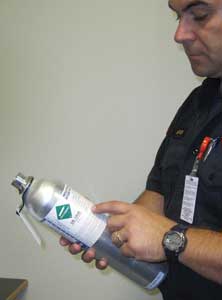 |
| (1) Photos by author. |
HARMFUL SUBSTANCES
Exposure to harmful substances can destroy sensors or at least reduce their accuracy. For example, holding a gas monitor next to an idling apparatus exhaust pipe will clog, coat, and corrode sensors (photo 2). Manufacturers generally provide a two-year sensor warranty. The O2 sensor tends to have the shortest lifespan because it is constantly exposed to oxygen. CO and H2S sensors usually last longer than two years. The LEL sensor lifespan will vary based on its exposure to high concentrations of flammable gases or poisons. LEL sensor poisons include silicone vapors (found in caulking, moisture-removing lubricants, and some vehicle appearance care products), leaded gasoline vapors, diesel exhaust, and refrigerant gases (freons). Simple preventive measures such as storing the device in an interior compartment, not an exterior one (exposure to cold reduces battery life), and not allowing the device to get immersed or even soaking wet (water is bad for electronics) can avoid on-scene frustration. The only way to ensure that your gas monitor and the numbers it displays are accurate is through regular calibration and daily inspection.
 |
| (2) |
There is more to using a gas monitor than knowing how to turn it on and off. Firefighters need confidence in their ability to accurately interpret what the gas monitor is telling them. This confidence is developed through training and experience.
LAG TIME
Gas monitors do not provide instantaneous results. It takes between 20 seconds and two minutes for a gas sensor to process a sample of gas and display a number, which is called the “lag time.” If you are walking nonstop from room to room noting gas readings, any numbers the monitor produces will not accurately reflect the gas concentrations in your current location. If you are using tubing or an extension probe, the lag time will be longer, typically an additional two seconds per foot of tubing or probe. Check your monitor’s operating manual to confirm the lag time of particular sensors (photo 3).
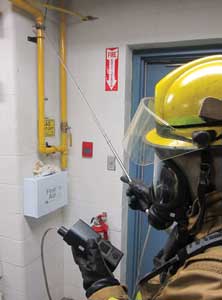 |
| (3) |
A gas sensor can sense only target gases that are in close proximity to the sensor or directly in front of the inlet port of attached tubing/probe. Gases can sink, rise, hang around, or do any combination of movements depending on their vapor density, natural or manmade air currents, temperature, and weather conditions. Using the three-step low/middle/high gas sampling technique will improve your chances of finding target gases.
First, hold the gas monitor low below your knees for 20 seconds. Most gases are heavier than air, which is the reason we start low. If during those 20 seconds the numbers start to change, wait a full two minutes before reading the number (photo 4).
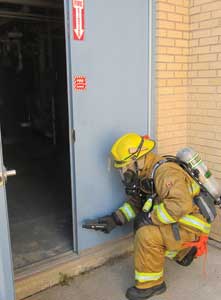 |
| (4) |
Second, move the monitor to waist height for 20 seconds. If during that 20-second interval the numbers start to change, wait a full two minutes before reading the number (photo 5).
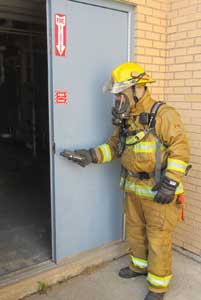 |
| (5) |
Third, move the monitor above your head for 20 seconds. If during those 20 seconds the numbers start to change, wait a full two minutes before reading the number (photo 6).
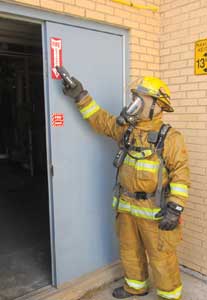 |
| (6) |
Repeat this low/middle/high technique at any entrance to a structure, room, or point of interest within the investigation area. If more than one gas monitor is available, take advantage of this resource. Extra monitors will reduce the amount of time spent hunting for the source of a gas leak. They will also provide redundancy and confirm any unusual readings.
If any sensor has been exposed to a concentration of gas beyond its maximum detection limit, the sensor display may read “OR” (over range), “+++” symbols, or “ERR” (error). Check your operations manual to confirm how your sensors will react. Newer LEL sensors will also turn themselves off to prevent deadly exposure to a high concentration of flammable gas.
OXYGEN AND LEL
Always check O2 levels when monitoring for flammable gases. The LEL sensor requires a specific amount of O2 to function properly. If less than the required amount of O2 is present, the LEL sensor will produce an inaccurate number. Check your operations manual to confirm the minimum amount of O2 your LEL sensor requires. When less than the minimum amount of O2 is present, a diffusion sampling technique is required so the LEL sensor will produce an accurate reading. A confined space or hazardous materials team should be equipped to conduct diffusion sampling. The CO and H2S sensors do not require O2 when monitoring.
FALSE POSITIVES
Some nontarget gases that are chemically similar to your target gas may produce a “false positive” or a sensor reading that is not the result of exposure to a target gas. CO and H2S sensors routinely produce false positives. Some sources of CO and H2S false positives are listed in Table 1.
|
|
 |
Nontarget gases do not affect the LEL sensor. Humidity (moisture in the air) and oxygen-displacing gases affect the O2 sensor and will lower its readings. An O2 reading of 20.9 percent by volume is considered normal.
EXPOSURE LIMITS
Exposure to any hazardous material can be considered safe as long as the exposure is below a specific amount. The authority having jurisdiction (AHJ) will mandate an exposure standard for your fire department to follow. The intent of this standard is to protect firefighters and civilians from exposure to dangerous concentrations of hazardous materials. The AHJ standard is usually adapted from the Occupational Safety and Health Administration (OSHA), NIOSH, or the American Conference of Governmental Industrial Hygienists (ACGIH). The “time weighted average” (TWA) is a term OSHA, NIOSH, and the ACGIH use. The OSHA and the ACGIH TWA state that a healthy worker can be safely exposed to a specific amount of a specific hazardous material for eight hours a day, 40 hours per week with no adverse health effects. The NIOSH TWA is based on a weekly exposure rate of 10 hours a day, 40 hours a week.
You can use the TWA as a conservative respiratory protection decision-making benchmark. For example, most gas sensors have two alarms. Set the first alarm below the TWA to warn firefighters that they must be prepared to evacuate civilians and don respiratory protection. Set the second alarm at the TWA. At this final alarm, firefighters must ensure that all civilians have been evacuated and that all firefighters have donned respiratory protection. The ACGIH TWA for CO is 25 parts per million (ppm); for H2S, it is 10 ppm.
In addition to respiratory protection requirements, firefighters must also know when conditions are untenable. Many fire departments use 10 percent of LEL as benchmark for flammable gas incidents. A reading of 0.0 percent of LEL is considered safe. A reading between 1.0 and 10 percent of LEL is unsafe for civilians but safe for firefighters wearing respiratory protection and personal protective equipment (PPE). Readings greater than 10 percent of LEL are considered dangerous. Evacuate everyone until LEL readings are below 10 percent. O2 readings between 19.5 and 23 percent by volume are generally considered safe. Readings of less than 19.5 percent by volume are unsafe for civilians but safe for firefighters wearing respiratory protection. O2 readings above 23 percent by volume are dangerous because the ignition point of all materials has been lowered. Exit the hazard area immediately if the LEL or O2 sensors have been compromised by high concentrations of gas, poisions, or low O2 levels.
It’s not practical or possible for a first-due company to detect every gas or vapor that may be encountered. Remember, you can’t help anyone if you’re dead, and you can’t enjoy retirement if you have cancer. Wear full PPE including respiratory protection during suspicious odor investigations and overhaul.
FLAMMABLE GASES
Flammable substances are the most frequently encountered hazardous materials. The LEL sensor in conjunction with the O2 sensor will be used to size up this invisible threat. As mentioned earlier, many fire departments deploy a single-sensor gas monitor equipped with a CO sensor. A CO sensor is not designed to detect any flammable gas or vapor. Don’t use a CO sensor to detect propane, natural gas, gasoline or diesel vapors, or anything else that will burn.
CORROSIVE GASES
Corrosive substances are the second most commonly encountered hazardous materials. The standard multisensor package (LEL, O2, CO, H2S), will not detect corrosive gases. Strong corrosive gases with high vapor pressure will destroy these sensors and burn firefighters through their bunker gear. By simply attaching a small piece of inexpensive universal pH paper to the top of your gas monitor, you can reduce the risk of exposure to corrosive gases. The pH paper turns dark red if a strong acid is present and dark blue if a strong base is present. In either situation, withdraw to a safe location and call a hazardous materials team (photo 7).
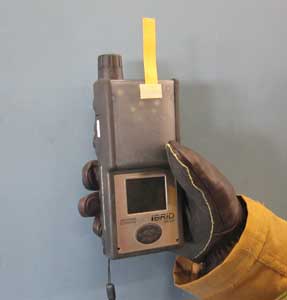 |
| (7) |
TOXIC GASES
Flammable gases will reach toxic levels long before they are within their flammable range. CO and H2S sensors are not designed to determine the toxicity of flammable gases. CO is a toxic, colorless, odorless, and tasteless gas. A product of combustion, it is commonly found where fuel-burning appliances are malfunctioning. Firefighters use positive-pressure ventilation to clear structures of the products of combustion. A positive-pressure fan’s gasoline engine will increase CO levels inside the building when running outside the entrance of a building.
H2S is a toxic, colorless gas that smells like rotten eggs and is produced when organic materials decay. The most significant sources of H2S are petrochemical industries and wastewater facilities. Ethyl mercaptan, an odorant that also smells like rotten eggs, is added to propane and natural gas so that people can detect leaks by smell. If you can smell rotten eggs, you may not necessarily be dealing with H2S.
Finally, don’t compare your gas detection equipment to that of the utility company. The utility company uses different sensors that are more sensitive, designed to detect gas in very minute concentrations. These sensors have higher maintenance requirements and are more sensitive to nontarget gases.
When a gas monitor fails to perform as expected, firefighters are quick to remark, “That gas monitor is a piece of junk.” The truth is that neglect of routine maintenance and a lack of knowledge are typically the sources of most gas detection problems. Modern technology has not eliminated the need for ongoing maintenance and training. Basing decisions on the readings of poorly maintained equipment or on the interpretations of untrained personnel is a recipe for disaster.
BRUCE LAKE is a hazardous materials technician and chemical, biological, radiological, and nuclear specialist with Halifax Regional Fire and Emergency in Nova Scotia, Canada. He is a graduate of the Fire Service Management Program at Dalhousie University. Prior to joining the fire service, Lake served in the Canadian Army as a nuclear, biological, and chemical defense officer.

